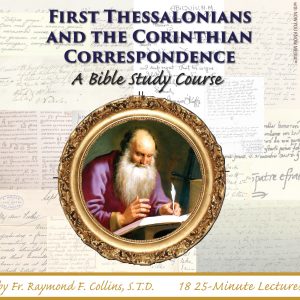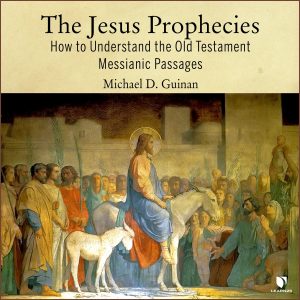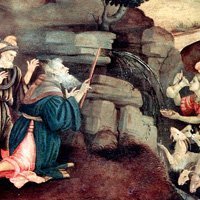Audio Sample:
Embark on a powerful journey through the miracles of Jesus and His disciples.
Stories about Jesus’ miracles have enthralled men and women for the past two thousand years. Now, you can take a closer look at these miraculous stories in the four Gospels, the Acts of the Apostles, and the letters of Paul.
Your guide is renowned New Testament scholar Fr. Raymond Collins, S.T.D. You will begin by studying the nature of miracles, the different types of biblical miracles, and how miracle workers were understood in biblical times and early Christianity. Then, you will journey through Scripture, gaining a fuller picture of Christ and his disciples.
First, you will look at each of the Synoptic Gospels, gaining an appreciation for how Matthew and Luke developed the stories in Mark. Then, you will explore the Gospel of John, looking
Audio Sample:
Embark on a powerful journey through the miracles of Jesus and His disciples.
Stories about Jesus’ miracles have enthralled men and women for the past two thousand years. Now, you can take a closer look at these miraculous stories in the four Gospels, the Acts of the Apostles, and the letters of Paul.
Your guide is renowned New Testament scholar Fr. Raymond Collins, S.T.D. You will begin by studying the nature of miracles, the different types of biblical miracles, and how miracle workers were understood in biblical times and early Christianity. Then, you will journey through Scripture, gaining a fuller picture of Christ and his disciples.
First, you will look at each of the Synoptic Gospels, gaining an appreciation for how Matthew and Luke developed the stories in Mark. Then, you will explore the Gospel of John, looking at its unique treatment of miracles, the wedding miracle at Cana, and the notion of a Johannine “sign.” After exploring John, you will examine the only miracle story told in all four Gospels: the feeding of the multitudes. You will also encounter the works of the apostles, who were commissioned by Jesus to “work miracles.”
The miracles of Jesus portray Christ in action, and the works of the apostles show how we are all called to follow the Lord. Experience the power of miracles today.
*This course was previously sold under the title Good News: The Miracles of Jesus and His Disciples
Learn about downloadable programs.
Your Free Electronic Study Guide! When you order this course, we will send you a free electronic study guide that you can access in 3 convenient ways:
1) You can check your order confirmation email. It will include a link that enables you to download your guide.
2) The back of your program package also contains a copy of this link. You can access your guide by simply entering this URL into your browser.
3) Your case of CDs or DVDs will contain a copy of your electronic guide on CD. Simply insert this disc into your computer’s CD/DVD drive to access your guide.
$17.99




You must be logged in to post a review.
© 2021 Learn 25 | Privacy Policy | Terms of Use | MP3 Downloads | Customer Support
Stay in the know.
Enter your email address for a free coupon, and to find out about future specials and promotions. You may unsubscribe at any time.


In an effort to provide our customers the best possible experience, we have created a new website for you at Learn25.com to browse our selection of over 400 audio and video courses by top professors.
Andrea L. Molinari –
Solid Introductory Course
If you are interested in studying the miracle stories in the New Testament, a good place to begin is with Fr. Raymond F. Collins’ Good News: The Miracle Stories of Jesus and His Disciples, available in both video and audio formats from Now You Know Media.
Collins’ course begins by helping the student gain a sense of cultural context by exploring a rich collection of miracle stories from the ancient world. This collection includes an examination of miracle stories associated with Old Testament figures such as Moses, Elijah and Elisha. However, Collins does not stop there. He proceeds to discuss the various Jewish figures, rabbis (e.g., Chanina ben Dosa) and those whom we would label as exorcists, who were known in Jesus’ day. Further, Collins even notes that public figures like the Emperor Vespasian had miracles attributed to them!
In keeping with the structure of the course, which promises to focus on the miracle stories of Jesus and his disciples, Collins proceeds to survey a host of early Christian miracle stories attributed to various apostles, largely derived from the apocryphal acts of the apostles (ca. 2nd to 4th centuries). While hardly encyclopedic, which would have been impossible given the limitations of the course, Collins gives a good, solid sampling, certainly enough to pique the listener’s interest in this literature.
Throughout this lecture, Collins demonstrates a true enjoyment of the stories he shares. His sense of irony and, when appropriate, the humorous qualities of some of these stories is truly infectious and serves to motivate the student to delve ever deeper into this course.
Lecture 2 opens the discussion of what a miracle is and notes by way of proof of this assertion that the index to The Catechism of the Catholic Church does not have an entry for “miracle,” even though it does have entries for “exorcisms” and “healings as signs of Jesus’ divinity.” Collins’ solution to this problem, like many New Testament scholars before him is to rely on the insights of Form Criticism.
This type of scriptural analysis was made famous in New Testament research by scholars like Martin Dibelius and Rudolf Bultmann. Form critics believe that as the stories about Jesus were circulated, they were shaped into forms according to principles of oral communication — miracle stories, parables, etc. As these stories were told and retold they took on additional details and emphases, and new stories were created to meet the ongoing needs of the believing community. The intent of the form critic was to find the Sitz im Leben, the “situation in life” where such oral forms originated and developed. Although some of the earliest oral units were thought to go back to Jesus himself, many of the traditional forms were created and shaped by the community itself. The evangelists were viewed by the form critics primarily as collectors or editors of these traditional units.
Collins draws on this type of analysis when he describes the three-part literary form of a miracle story (i.e., The Difficulty; The Resolution; and The Proof of the miracle) and his explanation of the four kinds of miracle stories in the New Testament (i.e., Exorcism; Healings; Resuscitations; and Nature Miracles).
Having established the formal components of a miracle story, Collins proceeds to demonstrate how this structure can be applied to Gospel stories in Lecture 3. He accomplishes this by focusing his attention on Mark 1, which includes a sequence of miraculous actions of Jesus which are said to take place in a single day. Collins applies his three-part form of a miracle story to the story of Jesus’ exorcism of a demoniac in the Capernaum synagogue (Mark 1:23-28) and Jesus’ healing of Simon’s mother-in-law (Mark 1:29-31). This lecture is helpful in that it begins to demonstrate to the student how New Testament scholars analyze miracle stories.
This leads to the next three lectures (Lectures 4, 5, and 6) which cover miracle stories in Mark, Matthew and Luke respectively. These lectures begin to acquaint the student with some of the ways that each gospel writer adapts the stories to their own theological purposes. However, as one would expect from the fact that each gospel writer’s use of miracles is being summarized in about 25 minutes, these lectures can scarcely do more than suggest areas for further exploration (e.g., Matthew’s special collection of miracles related to Peter and Luke’s use of Isaiah’s prophecies [namely Isa 61:1-2; 58:6] to characterize Jesus’ ministry in Luke 4:18-19 and its subsequent fulfillment throughout the rest of Luke’s gospel).
The next three lectures (Lectures 7, 8, and 9) are a definite strength in this series. This is hardly surprising given Collins’ extensive and highly-respected background in Johannine research, teaching, and scholarly publication.
The first (Lecture 7) begins by discussing John’s preferred use of the Greek word sēmeia, “signs” for actions we would call miracles. Collins’ specialization in John shines through as he does a fine job of summarizing key aspects of scholarly inquiry into Johannine signs. Collins notes that signs were intended to evoke faith (e.g., John 2:11; 20:31) but that this was not always the result (John 12:37). Collins explains that there are seven major Johannine signs (along with summary statements that allude to the existence of many others; see John 20:30-31). He states that of these seven major signs, three of these replicate stories found in the Synoptic Gospels and four do not. Collins repeats the question asked by many New Testament scholars (and answered by many in the affirmative): Was there a pre-existent “Signs Source” that was used by the evangelist? (Honestly, the idea that early Christians collected different types of traditions about Jesus is not radical or surprising. If one reads Matthew’s Gospel, it is very clear that Matthew GROUPS/ COLLECTS various types of tradition such as miracles [Matt 8-9], parables [Matt 13] and speech materials [e.g., Matt 5-7]).
Collins follows this introductory lecture on Johannine signs with two lectures that discuss the first sign, the Water Become Wine (John 2:1-11) and the only sign that appears in all four canonical gospels, the Feeding of the Five Thousand (John 6:1-15). These two lectures, because they focus on individual signs, allow the student the chance to see Collins engage in a more detailed analysis and Collins does not disappoint.
With Lecture 10, the course returns to a discussion of miracles attributed to the apostles, a topic last broached in Lecture 1 with its brief survey of early Christian miracle stories taken from the various apocryphal acts of the apostles. Here Collins takes a direction that is surprising in that he begins his examination by focusing on summary statements in the gospels that refer to the apostles’ miracle working charge, part of a general commissioning by Jesus, and the subsequent results of their missionary activity as described in these short gospel passages. From this, Collins then examines several passages in the Acts of the Apostles that describe the apostles miracles, with a special focus on Peter’s activity.
Lecture 11’s focus is on Paul’s miracles and begins with several key passages from the second half of the Acts of the Apostles. These miracles in Acts are quite dramatic and include the use of objects touched by Paul and then sent to those who need healing (Acts 19:11-12), the resurrection of a boy who fell to his death (Acts 20:7-12), and Paul’ ability to endure a viper bite and cure various sick people while he was shipwrecked on the island of Malta (Acts 28:1-9). Collins makes the interesting point that, while Acts presents Paul as openly and boldly working miracles, Paul’s own writings are more subdued in their discussion of such things. Instead, Collins notes how Paul, despite acknowledging his ability to prophecy and work miracles (1 Cor 13:2-3), seems unwilling to go into any sustained description of these activities.
Lecture 12 brings the series to a close by exploring several major areas of theological consideration including miracles and faith, miracles and their relationship to the Kingdom of God and the Christological dimension of miracles.
On the whole, Collins’ work represents a good, solid introduction to the topic of the miracles of Jesus and the apostles. However, it is best suited for beginners as its brevity greatly inhibits its ability to achieve depth.